Sizing Up Servers: Intel's Skylake-SP Xeon versus AMD's EPYC 7000 - The Server CPU Battle of the Decade?
by Johan De Gelas & Ian Cutress on July 11, 2017 12:15 PM EST- Posted in
- CPUs
- AMD
- Intel
- Xeon
- Enterprise
- Skylake
- Zen
- Naples
- Skylake-SP
- EPYC
Intel’s Turbo Modes
A last minute detail from Intel yesterday was information on the Turbo modes. As expected, not all of the processors actually run at their rated/base frequency: most will apply a series of turbo modes depending on how many cores are registered as ‘active’. Each core can have its frequency adjusted independently, allowing VMs to take advantage of different workload types and not be hamstrung by occupants on other VMs in the same socket. This becomes important when AVX, AVX2 and AVX-512 are being used at the same time.
Most of the turbo modes are a sliding scale, with the peak turbo used when only one or two cores are active, sliding down to a minimum frequency that may be the ‘base’ frequency or just above it. There’s a lot of information for the parts here, so we’ll break it down into stages.
First up, a look at the Platinum 8180 in the different modes:
It should be worth noting what the base frequency actually is, and some of the nuance in Intel’s wording here. The base frequency is the guaranteed frequency of the chip – Intel sells the chip with the base frequencies as the guarantee, such that when the chip is not idle and not in normal conditions (i.e. when not in thermal power states to reduce temperature) should operate at this frequency or above it. Intel also lists the per-core turbo frequencies as ‘Maximum Core Frequencies’ indicating that the processors could be running lower than listed, depending on power distribution and requirements in other areas of the chip (such as the uncore, or memory controller). It’s a vague set of terms but ultimately the frequency is determined on the fly and can be affected by many factors, but Intel guarantees a certain amount and provides guides as to what it expects the turbo frequencies to be.
As for the Platinum 8180, it keeps its top turbo modes while up to two cores are active, and then drops down. It does this again for another two cores, and a further two cores. From this point, under non-AVX load the CPU is pretty much the same frequency until >20 cores are loaded, but does not decrease that much in all. For AVX 2.0 and AVX-512, the downward slope of more cores means less frequency continues, with AVX-512 taking a bigger jump down at 13 cores loaded. The final turbo frequency for AVX-512 running on all cores is 2.3 GHz.
Comparing the two 28-core CPUs for which we have turbo information gives this graph. The numbers relate to the number of cores need to be loaded for that frequency.
Both processors are equal to each other for dual core loading, but the separation occurs when more cores are loaded. As we move through to AVX 2.0 and AVX-512, it is clear where the separations are in performance – to get the best for variable core loading, the more expensive processors are required.
Here’s the big table for all the processors on Non-AVX loading:
Despite the 2.0/2.1 GHz base on most of the Platinum series, all the CPUs will turbo up to 3.7-3.8 GHz on low core loading except for the lower power Platinum 8153. For users wanting to strike a good balance between the core count and frequency, the Gold 6154 is probably the place to be: 18 cores that will only ever run at 3.7 GHz with non-AVX loading (3.5-2.7 GHz on AVX-512 depending on core count), and will be $3543 as a list price at 205W. It is perhaps worth noting that this will likely top any of the Core i9 processors planned: at 18-cores and 205W for 3.7 GHz, the Core i9-7980XE which will have 18 cores but run 165W will likely be clocked lower (but also only ~$2000).
Moving onto AVX2.0 and AVX-512:


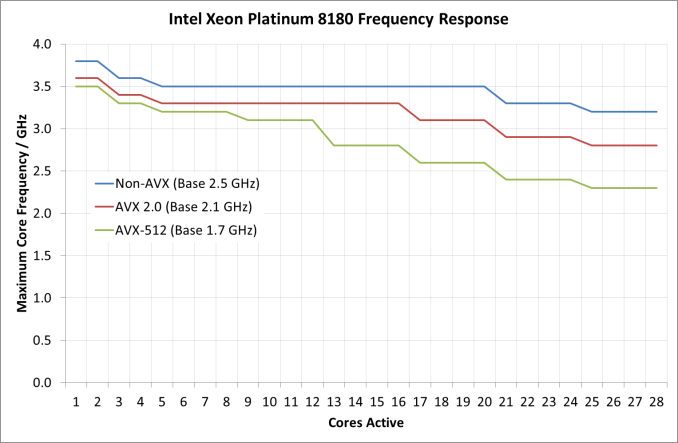
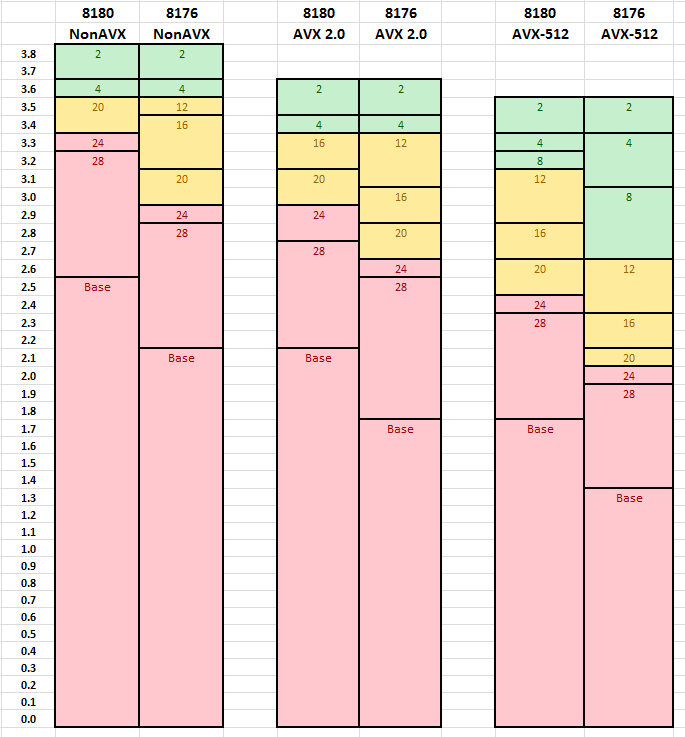
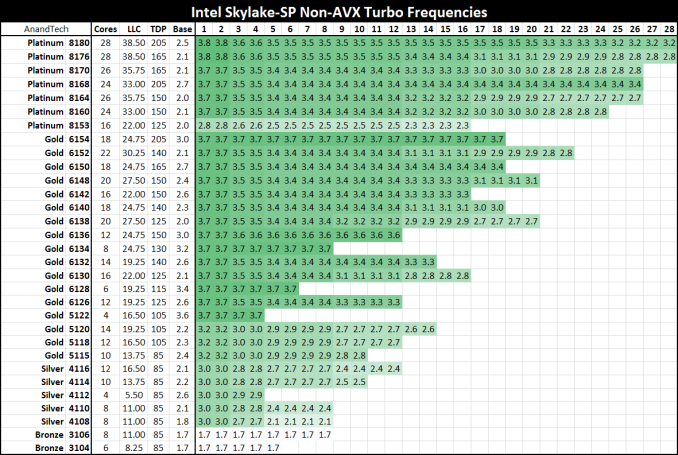
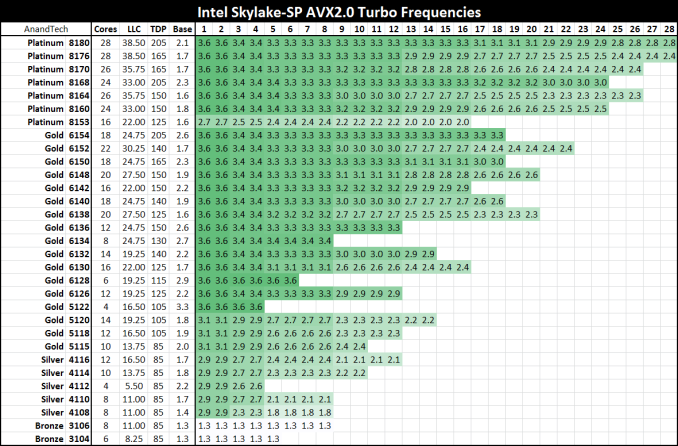
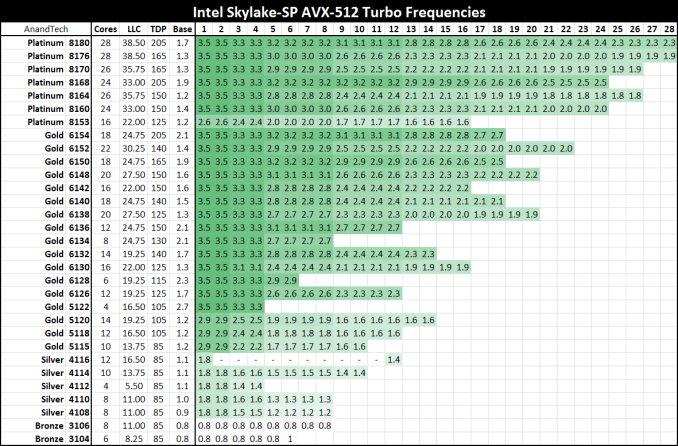








219 Comments
View All Comments
psychobriggsy - Tuesday, July 11, 2017 - link
Indeed it is a ridiculous comment, and puts the earlier crying about the older Ubuntu and GCC into context - just an Intel Fanboy.In fact Intel's core architecture is older, and GCC has been tweaked a lot for it over the years - a slightly old GCC might not get the best out of Skylake, but it will get a lot. Zen is a new core, and GCC has only recently got optimisations for it.
EasyListening - Wednesday, July 12, 2017 - link
I thought he was joking, but I didn't find it funny. So dumb.... makes me sad.blublub - Tuesday, July 11, 2017 - link
I kinda miss Infinity Fabric on my Haswell CPU and it seems to only have on die - so why is that missing on Haswell wehen Ryzen is an exact copy?blublub - Tuesday, July 11, 2017 - link
Your actually sound similar to JuanRGA at SAKevin G - Wednesday, July 12, 2017 - link
@CajunArson The cache hierarchy is radically different between these designs as well as the port arrangement for dispatch. Scheduling on Ryzen is split between execution resources where as Intel favors a unified approach.bill.rookard - Tuesday, July 11, 2017 - link
Well, that is something that could be figured out if they (anandtech) had more time with the servers. Remember, they only had a week with the AMD system, and much like many of the games and such, optimizing is a matter of run test, measure, examine results, tweak settings, rinse and repeat. Considering one of the tests took 4 hours to run, having only a week to do this testing means much of the optimization is probably left out.They went with a 'generic' set of relative optimizations in the interest of time, and these are the (very interesting) results.
CoachAub - Wednesday, July 12, 2017 - link
Benchmarks just need to be run on as level as a field as possible. Intel has controlled the market so long, software leans their way. Who was optimizing for Opteron chips in 2016-17? ;)theeldest - Tuesday, July 11, 2017 - link
The compiler used isn't meant to be the the most optimized, but instead it's trying to be representative of actual customer workloads.Most customer applications in normal datacenters (not google, aws, azure, etc) are running binaries that are many years behind on optimizations.
So, yes, they can get better performance. But using those optimizations is not representative of the market they're trying to show numbers for.
CajunArson - Tuesday, July 11, 2017 - link
That might make a tiny bit of sense if most of the benchmarks run were real-world workloads and not C-Ray or POV-Ray.The most real-world benchmark in the whole setup was the database benchmark.
coder543 - Tuesday, July 11, 2017 - link
The one benchmark that favors Intel is the "most real-world"? Absolutely, I want AnandTech to do further testing, but your comments do not sound unbiased.